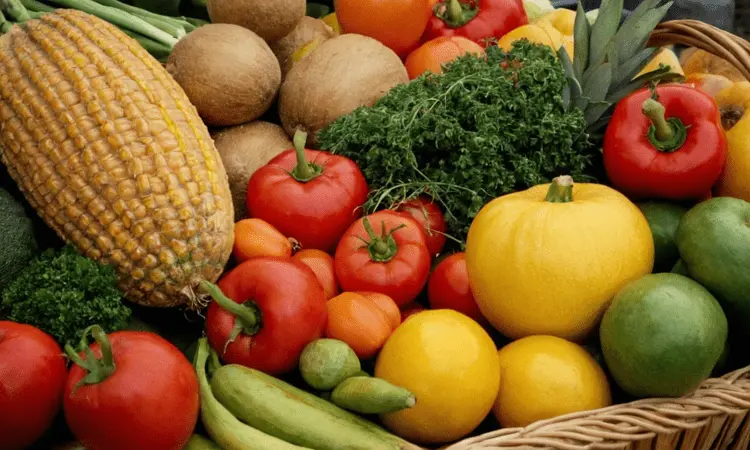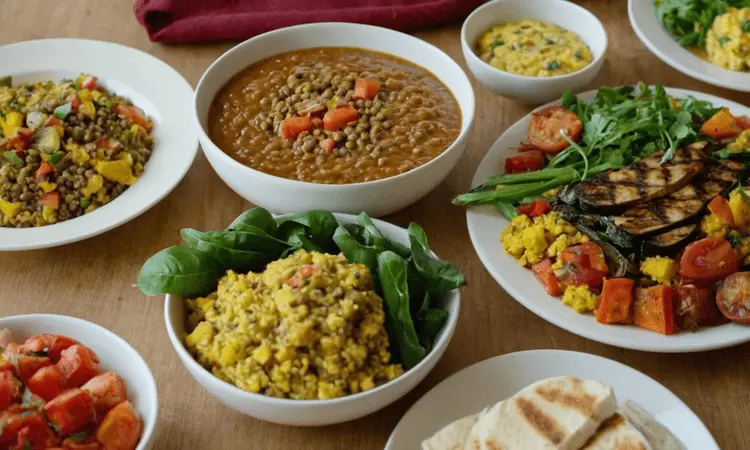The flexitarian diet might be the solution if you’re interested in a plant-based diet but find going fully vegetarian or vegan too daunting. You know eating more plants is good for you, but you don’t want to feel deprived or completely change your eating habits overnight.
You want to eat healthier and feel better, but you also don’t want to feel deprived or overwhelmed with complex dietary changes.
Enter the flexitarian diet! This flexible, semi-vegetarian approach allows you to reap the benefits of plant-based eating while still enjoying the foods you love in moderation. It’s a simple, sustainable way to improve your health without sacrificing your favorite flavors.
Flexitarian Diet in a Nutshell
- Focus on plant-based foods
- Include meat in moderation
- No strict rules, it’s flexible
- Offers many health benefits
- Sustainable for the environment
Table of contents
Introduction

The Flexitarian Diet: Your Guide to Flexible, Plant-Forward Eating
Tired of restrictive diets? Want to eat healthier without sacrificing the foods you love? The flexitarian diet might be the perfect solution for you.
Think of it as a choose-your-own-adventure approach to healthy eating. It’s all about focusing on plants while still allowing flexibility for those occasional cravings.
What is the Flexitarian Diet? A Definition and Its Benefits
So, what exactly is the flexitarian diet? In a nutshell, it’s a plant-forward style of eating that encourages limiting meat consumption without entirely eliminating it.
Here’s why the flexitarian diet is gaining popularity:
- Weight Management: Naturally lower in calories, yet satisfying.
- Disease Prevention: Linked to a reduced risk of heart disease, diabetes, and more.
- Easy to Follow: No strict food rules, just mindful choices.
- Good for the Planet: Reduces your environmental impact.
Ready to give the flexitarian diet a try? If so, you’re in the right place! Want to learn more about plant-based eating basics? Explore this beginner’s guide .
How to Start the Flexitarian Diet
It’s Not All-Or-Nothing: Levels of Flexitarianism
Starting a new way of eating can feel overwhelming. But with the flexitarian diet, it’s all about progress, not perfection! Think of it as a spectrum:
- Beginner Flexitarian: 2-3 meatless days per week
- Advanced Flexitarian: 3-5 meatless days per week
- Expert Flexitarian: Mostly vegetarian, with occasional meat
Where do you see yourself starting? There’s no wrong answer – choose a level that feels achievable for you!
Focus on Plants, Not Perfection
The beauty of the flexitarian diet is its simplicity. Focus on adding more delicious plant-based foods to your plate. Here’s how to get started:
- “Crowd Out” Meat: Instead of eliminating meat, gradually reduce portions and make plants the star of your meals.
- Explore New Flavors: Experiment with different beans, lentils, tofu, whole grains, and veggies. You might be surprised how satisfying they are!
- One Meal at a Time: Start with plant-based breakfasts, meatless Mondays, or swap out one usual meat-heavy dinner each week.
Think about it – how can you add more plants to your meals this week? Let’s share ideas in the comments!
Swaps and Substitutions Made Easy
Transitioning to a flexitarian diet doesn’t mean overhauling your entire recipe collection. Easy swaps make it a breeze! Here are a few favorites:
- Taco Tuesday Transformation: Switch ground beef for seasoned black beans or lentils.
- Meatless Bolognese: Use crumbled tempeh or mushrooms for a hearty sauce.
- Burger Swap: Try veggie burgers, portobello mushroom burgers, or bean-based patties.
Did you know a plant-based diet has been scientifically linked to remarkable improvements in heart health? Want to know more? Click here…
What to Eat on a Flexitarian Diet
Build Your Plate with These Powerhouse Foods
Let’s ditch the boring salads and explore the delicious variety a flexitarian diet offers! Think of your plate as a canvas for vibrant colors, textures, and satisfying flavors. Here’s your flexitarian food toolkit:
- Protein Powerhouses:
- Beans, lentils, tofu, tempeh, eggs, nuts, and seeds
- Smaller portions of poultry, fish, and lean red meat (optional)
- Vibrant Veggies: Pile on all sorts – leafy greens, sweet potatoes, broccoli, you name it!
- Fabulous Fruits: Berries, apples, citrus – enjoy them fresh or in dishes.
- Whole Grains: Think brown rice, quinoa, oats, whole-wheat bread.
- Healthy Fats: Avocado, olive oil, nuts, and seeds (in moderation).
Don’t Forget These Essential Nutrients
A balanced flexitarian diet is key to feeling your best. Be mindful of these nutrients:
- Iron: Found in lentils, tofu, leafy greens (pair with vitamin C for better absorption).
- Calcium: Dairy or fortified plant-based milk, leafy greens, certain tofu varieties
- Vitamin B12: Dairy, eggs, fortified plant-based milk, nutritional yeast. Supplements may be necessary.
- Omega-3s: Fatty fish, flax seeds, chia seeds, walnuts.
Don’t be afraid to experiment and discover new favorites! Share your tasty flexitarian meal creations with me on social media.
Flexitarian Meal Ideas and Recipes

A Week of Delicious Flexitarian Meals
Variety is the spice of life – and of the flexitarian diet! Let’s explore a sample week of satisfying, plant-forward meals to show you just how easy and tasty this lifestyle can be.
- Monday: Veggie-Packed Black Bean Burgers (easily made meatless!)
- Tuesday: Tofu Scramble with Roasted Sweet Potatoes
- Wednesday: One-Pot Lentil and Vegetable Curry
- Thursday: Salmon with Roasted Vegetables
- Friday: Tempeh Stir-Fry with Whole-Grain Noodles
- Saturday: Build-Your-Own Vegetarian Pizza Night
- Sunday: Mediterranean Chickpea Salad
This is just a starting point! Feel free to mix and match based on your preferences. Craving something sweet? Search for delicious flexitarian desserts for the perfect finish.
Recipe Inspiration: Where to Find Flavorful Flexitarian Dishes
Need more ideas? Don’t worry, there’s a whole world of flexitarian-friendly recipes out there! Here are a few places to start:
- Dedicated Flexitarian Cookbooks: Seek out cookbooks specifically focused on this style of eating.
- Plant-Based Food Blogs: Many plant-based blogs offer fantastic recipes with simple modifications to include your choice of protein. Try browsing a plant-based recipe guide for beginners [link out to external resource #1].
- General Recipe Websites: Search your favorite sites using terms like “vegetarian” or “plant-based” to uncover tons of options.
The flexitarian diet is all about flexibility and making it your own! Have a favorite recipe that’s usually meat-centric? Think about creative plant-based substitutions to give it a flexitarian twist!
Beyond the Diet: Flexitarian Lifestyle
Mindful Eating on a Flexitarian Diet
The flexitarian diet encourages a more mindful approach to food. Instead of strict rules, it’s about tuning into your body’s signals. Ask yourself: Am I truly hungry? What foods will nourish and satisfy me?
Here are ways to practice mindful eating:
- Slow Down and Savor: Take time to appreciate the flavors, textures, and aromas of your food.
- Minimize Distractions: Put away your phone and focus on the meal in front of you.
- Listen to Your Body: Pay attention to your fullness cues and stop eating when comfortably satisfied.
Mindful eating helps you develop a more positive and intuitive relationship with food. Have you tried any mindful eating techniques? Share your experiences in the comments!
Flexitarian Diet for Sustainability
One of the often-overlooked benefits of the flexitarian diet is its positive environmental impact. Reducing meat consumption decreases your carbon footprint. It contributes to more sustainable food production.
Let’s make a difference, one delicious flexitarian meal at a time! Do you consider environmental impact when making food choices?
Flexitarian Diet Myths and Misconceptions
Tired of hearing the same old misconceptions about the flexitarian diet? Let’s set the record straight and debunk some common myths.
Myth 1: You won’t get enough protein on a flexitarian diet.
Fact: With a little planning, it’s incredibly easy to get sufficient protein as a flexitarian! Plant-based protein sources abound – think beans, lentils, tofu, nuts, seeds, and whole grains. Plus, you can still enjoy eggs, dairy, and occasional meat or fish.
Myth 2: The flexitarian diet is too restrictive.
Fact: This is the beauty of the flexitarian diet – it’s about flexibility! There are no strict food bans or calorie counting. You decide how often you want to include animal products, making it adaptable to your preferences and lifestyle.
Myth 3: It’s just a trendy fad.
Fact: Focusing on plant-based foods is backed by sound nutritional science. The flexitarian diet is a sustainable approach to eating that aligns with recommendations from many health organizations. Plus, research suggests it can offer numerous health benefits.
Ever heard any other flexitarian diet myths? Share them in the comments – let’s debunk them together!
Ready to ditch boring chicken for good? Discover surprisingly delicious plant-based proteins that will transform your flexitarian meals. Click here to explore!
Start Your Flexitarian Journey Today

The beauty of the flexitarian diet lies in its flexibility and ease. It’s not about restrictive rules, but about making conscious choices that benefit your health, the planet, and your taste buds!
Think about it: even small changes can make a big difference. Whether it’s starting with “Meatless Mondays” or simply adding more plant-based meals to your week, every step is a victory.
Remember, progress beats perfection on the flexitarian diet. Embrace the journey, explore new flavors, and discover the joy of eating in a way that feels both sustainable and delicious.
Flexitarian Diet: Quick Answers to Your Questions
Flexitarians primarily eat plants (fruits, vegetables, grains, legumes) but also include moderate amounts of meat, poultry, fish, eggs, and dairy.
It varies! There’s no set rule; some may eat meat a few times a week, others less frequently.
Weight loss is possible, as plant-focused diets are often lower in calories. However, it depends on overall calorie intake.
Yes, most flexitarians include eggs and dairy as part of their diet.
Nope! Include plant-based proteins like beans, lentils, tofu, and nuts, plus occasional meat or fish.
Definitely! The diet is flexible – find plant-based options that work for you and enjoy the freedom to choose.
Research shows plant-forward diets like this one promote better health, weight management, and may reduce disease risk.
Ease into it with simple swaps and get everyone involved in the kitchen. Focus on tasty, plant-based meals for success!